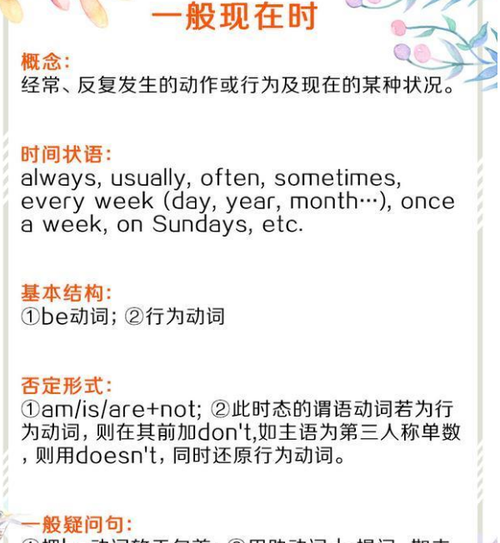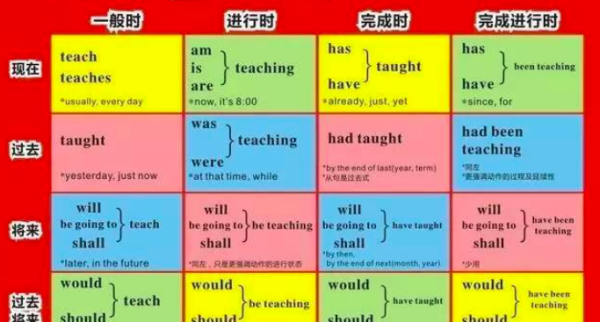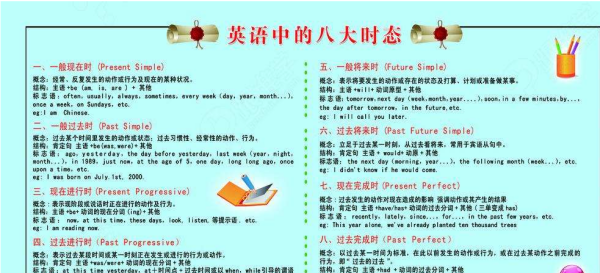本文目录
英语的八大时态的一张表
一)一般现在时。(do/does, am/is/are, 情态动词)
一般现在时表示的是客观事实或平时反复做的事情通常有频率副词always,usually,often,sometimes,seldom,once a week,every day等。
如:The earth goes around the sun.
Japan lies east of China.
He is never late for school.
He often gets up at six every day.
Cats can climb trees.
I hear they have moved into a new house.
He writes to his father once a year.
一般现在时还可以表示、安排好的,或即将发生的事,通常使用瞬间动词come,start,begin,return,leave等。
如:My plane leaves at 6:00 a.m..
Is there any meeting today?
The game starts at 8:00.
(二)现在进行时。(am/is/are doing)
现在进行时表示现在或最近正在做的事情,后面一般接延续性的动词,都表示动作没有进行完。
如:Look! The boy is dancing.
He is watching a football game.
What are you doing now?
They are preparing for the exam recently.
还常与always,usually,constantly,forever,continually等词连用表示一种语气,“总是,老是…”,
如:He is always working late.
Why are you always making this kind of mistake?
He is continually getting into trouble with the police.
后面接暂转动词时表示正在反复的动作,或表示将来时(一般只有go, come, leave和have)
如:The monkeys are jumping.
They are hitting the tree.
表将来:We are going swimming this afternoon.
They are leaving here.
They are having an English class tomorrow.
试比较:
He is doing his homework until his parents come to take him home.
He will do his homework until his parents come to take him home.
注:表示知觉、感觉、看法、认识、情感或愿望的动词和大部分暂转动词不能用现在进行时,如:see, hear, smell, taste, feel, like, hate, dislike, want, love, hate, want, know, forget, remember, understand, believe, suppose, mean, wish, hope, need, believe, refuse, suppose, have, fit, seem, fear, own等
(三)现在完成时
现在完成时中用瞬间动词表示说话时已经完成的动作,而且这个动作对现在还有影响,句中的时间副词主要有already, yet, now, by this time, by now等;用延续动词表示过去已经开始持续到现在而且还有可能继续持续下去的动作,句中的时间副词主要有this week, in the past/last/recent few years, since…, for…。
如:He has already finished his homework.
He hasn’t arrived here yet.
They have been here for ten years.
He has waited here since he came.
与一般过去时比较,看下面一段对话:
A: Have you seen my book? I think I have lost it.
B: Yes, I ______ (see) it on your table just now. But it ______(not be) there any longer. Where and when ______ you ______(lose) it?
A: I think I ______ (lose) it yesterday.
B: ______ you ______ (find) it?
A: ______.(Yes./No.)
现在完成时中的瞬间动词与延续动词的相互转化:
have finished/stopped/ended → have been over
have started/begun → have been on
have joined → have been in/a member of
have turned/become/got → have been
have left → have been away from
have arrived/reached/got to → have been
have died → have been dead
have married/got married to sb. → have been married to sb.
(四)一般将来时。(will/shall do, am/is/are going to do, am/is/are doing, am/is/are about to do)
一般将来时表示将要发生或打算做的事情,
如:He will come back in two days.
When will he give the book back to me?
It’s going to rain.
We are going to hold a sports meeting next week.
They are leaving for New York.
He is about to leave.
(五)一般过去时。(did, was/were, 情态动词过去式)
一般过去时表示在过去的某个时间发生的具体事情,一般都要有表示过去的时间状语,
如:He went to school by bike yesterday.
We had a good time last night.
He could count to 1000 when he was three.
He was a teacher before.
注意:在直接引语转换成间接引语时时间状语的变化:
如:He said, “I did it yesterday.”
→ He said he did it the day before.
today → that day
yesterday → the/a/one day before
the day before yesterday → 2 days before
last week → the week before
2 weeks ago → 2 week before
tomorrow → the next day/the day after或one/a day later
the day after tomorrow → 2 days after/later
in a week/next week → the next week
in 2 weeks → 2 weeks after/later
(六)过去进行时。(was/were doing)
过去进行时表示在过去的某个具体时间里正在发生的事情,
如:He was reading newspaper at seven yesterday evening.
The Smiths are watching TV at nine last night.
When he got home, his mother was cooking.
或过去的某段时间里持续发生的事情,
如:I was studying English in London from 1990 to 1992.
He was washing the dishes from seven o’clock to seven thirty.
(七)过去完成时
表示在过去的一个动作之前就已经完成的动作,即过去之过去。注意与现在完成时不同的是过去完成时必须要有具体的时间状语。
如:The train had left before she got to the station.
They had learnt 2000 words by the end of last month.
He had been a doctor for 3 years before he came here.
He got back the book that he had left in the classroom.
No sooner had he got to the cinema than the film began.
Hardly had he got to the cinema when the film began.
注意:如果两个或几个动作连续发生且衔接紧密时用一连串的一般过去式即可。
如:He locked the door and went away.
Mr.Smith went to the market, bought some flowers and went to see his friends.
He sent a telegraph home before he left Paris.
(八)过去将来时。(would/should, was/were going to do, was/were doing)
过去将来时表示在过去某时就打算做的事情,或相对于过去将要发生的事情。
如:They were going swimming when I met them.
He said he would go to New York.
Yesterday he said it was going to rain, but it didn’t.
(九)复合时态。高中阶段所学到的复合时态主要有:
完成进行时,将来完成时和将来进行时。
完成进行时表示到目前为止一直在做某事。过去完成进行时还可以表示刚刚结束的进行动作。
如:He has been painting the house the whole morning.
They have been promising us to rise our salary these years.
They had been doing their homework for 3 hours before I came.
I asked him what he had just been doing?
He had just been sleeping before I got there.
将来完成时表示,到将来某时即将结束的动作。
如:We will have learnt 3000 English words by the end of next term.
They will have finished it by 12:00 tomorrow.
将来进行时表示将来某时正在进行的动作。
如:We will be sleeping at this time tomorrow.
She will be waiting there at 8 a.m. if you ask her to.

英语八大语态
英语八大时态分别是:一般现在时、一般过去时、现在进行时、过去进行时、现在完成时、过去完成时、一般将来时和过去将来时。
时态(tense)是一种动词形式,不同的时态用以表示不同的时间与方式。它是表示行为、动作、状态在各种时间条件下的动词形式。

扩展资料:
一、一般现在时
一般现在时,是一种英语语法形式。表示通常性、规律性、习惯性、真理性的动作或状态,或者动作有时间规律发生的事件的一种时间状态。在英语语法中,“时“指动作发生的时间,”态“指动作的样子和状态。
二、一般过去时
一般过去时表示过去某个时间里发生的动作或状态;过去习惯性、经常性的动作、行为。在英语语法中,“时“指动作发生的时间,”态“指动作的样子和状态。
三、现在进行时
现在进行时是英语的一种时态,表示现在进行的动作或存在的状态。在英语时态中,“时“指动作发生的时间,”态“指动作的样子和状态。现在进行时表示动作发生的时间是“现在”,动作目前的状态是“正在进行中”。
四、过去进行时
过去进行时(Past continuous tense或Past Progressive tense),表示过去在某一时间段或某一段时间内正在发生或进行的动作或状态。在英语时态中,“时“指动作发生的时间,”态“指动作的样子和状态。
五、现在完成时
现在完成时是过去的动作或状态持续到现在并且已经完成,对现在造成的影响,可能持续发生下去。在英语时态中,“时“指动作发生的时间,”态“指动作的样子和状态。
完成时态的构成分为两部分:一是助动词,二是实义动词的过去分词-ed。具体来说,用助动词have表示“时”,以表明动作发生的时间是在过去、现在还是将来;用过去分词来表示动作的“态”,以表明该动作已经完成。
六、过去完成时
过去完成时(The Past Perfect Tense):表示过去某一时间或动作以前已经发生或完成了的动作,对过去的某一点造成的某种影响或是结果,用来指在另一个过去行动之前就已经完成了的事件。
在英语时态中,“时“指动作发生的时间,”态“指动作的样子和状态。 它表示动作发生的时间是“过去的过去”,侧重事情的结果。
七、一般将来时
一般将来时表示将来某一时段的动作或状态,或将来某一段时间内经常的动作或状态。在英语时态中,“时“指动作发生的时间,”态“指动作的样子和状态。
一般将来时常常和表示将来的时间状语连用。如:tomorrow(明天), next week(下周 );in the future(将来);in a year(一年以后)等。 一般将来时由助动词shall(第一人称),will(所有人称) 动词原形构成。美式英语则不管什么人称,一律用will。或用主语+be动词 + going to 动词(be going to)
八、过去将来时
一般过去将来时表示从过去的某一时间来看将来要发生的动作或呈现的状态。在英语时态中,“时“指动作发生的时间,”态“指动作的样子和状态。 一般过去将来时的出发点是过去,即从过去某一时刻看以后要发生的动作或状态。
参考资料来源:百度百科-时态
初中英语八大时态总结归纳
1、一般现在时:概念:经常、反复发生的动作或行为及现在的某种状况。
标志性时间状语:
Always(总是), usually(通常), often(经常), sometimes(有时候), every week (day, year, month…), once a week, on Sundays ……
基本结构:当主语是第三人称单数时 当主语不是第三人称单数时;
肯定句 主语+动词单三+其他 肯定句主语+动词原形+其他;
否定句 主语+doesn’t+动词原形+其他 否定句主语+don’t+动词原形+其他;
一般疑问句 Does+主语+动词原形+其他 一般疑问句 Do+主语+动词原形+其他;
肯定回答 Yes,主语+does 肯定回答 Yes,主语+do;
否定回答 No,主语+doesn’t 否定回答 No,主语+don’t;
特殊疑问句 特殊疑问词(when,where,who,how ,etc.)+一般疑问句
例句: I never get up early on Sundays.
2、一般过去时:
概念:过去某个时间里发生的动作或状态;过去习惯性、经常性的动作、行为。
标志性时间状语:ago, yesterday, the day before yesterday, last week(year, night, month…), in 1989, just now, at the age of 5, one day, long long ago, once upon a time……
基本结构:主语+动词过去式+其他;
否定形式did+not+do+其他;
一般疑问句did+主语+do+其他?
例句: I went to Italy .I visited museums and sat in public gardens
3、现在进行时:
概念:表示现阶段或说话时正在进行的动作及行为。
标志性时间状语:now, at this time(在这一刻), these days……
基本结构:am/is/are+doing;
否定形式:am/is/are+not+doing;
一般疑问句:把be动词放于句首。
例句:He is practicing his guitar.他正在练习他的吉他。

4、过去进行时:
概念:(1)表示过去某段时间或某一时刻正在发生或进行的行为或动作。
(2)表示一个动作正在进行时,另一个动作突然发生了。
标志性时间状语:at this time yesterday, at that time(在那一刻)或以when、while引导的谓语动词是一般过去时的时间状语等。
基本结构:was/were+doing;
否定形式:was/were + not + doing;
一般疑问句:把was或were放于句首。
While与when
(1)用while连接(while只接doing)
例:My mother was cooking while I was doing my homework.(可以持续动作时态一致)
(2)when表示(when可以接doing或did,when后动作时间长,用doing,时间短,用did)
例:I was doing my homework when my mother came in.(间接表达了具体时间)。
例句: I was having breakfast when the telephone rang。
5、现在完成时:
概念:过去发生或已经完成的动作对现在造成的影响或结果,或从过去已经开始,持续到现在的动作或状态。
标志性时间状语:recently, lately, since(自从)…,for(长达)…,in the past few years, etc.
基本结构:主语+have/has+过去分词(done);
①肯定句:主语+have/has+过去分词+其他;
②否定句:主语+have/has+not+过去分词+其他.
③一般疑问句:Have/Has+主语+过去分词+其他.
④特殊疑问句:特殊疑问词或词组+一般疑问句(have/has+主语+过去分词+其他)?
例句: I have just received a letter from my brother.
6、过去完成时:
概念:以过去某时间为标准,在此前发生的动作或行为,或在过去某动作之前完成的行为,即“过去的过去”。
标志性时间状语: after,when, as soon as(一...就...), until, before, by the end of(到…为止) last year(term, month…)……
基本结构:主语+had+过去分词(done);
①肯定句:主语+had+过去分词+其他;
②否定句:主语+had+not+过去分词+其他;
③一般疑问句:Had+主语+过去分词+其他?
肯定回答:Yes,主语+had。
否定回答:No,主语+had not .
例句: The children ran away after they had broken the window.
As soon as the sun had set we returned to our hotel.
I had not understood the problem until he explained it .
7、一般将来时:
概念:表示将要发生的动作或存在的状态及打算、计划或准备做某事。
标志性时间状语:tomorrow, next day(week, month, year…),soon, in a few minutes, by…,the day after tomorrow……
基本结构:
①am/is/are/going to + do;
②will/shall + do.
否定形式:①was/were + not; ②在行为动词前加didn’t,同时还原行为动词。
一般疑问句:①be放于句首;②will/shall提到句首。
例句: I will meet him at the harbour early in the morning.
注:将来进行时will be doing 将来某时刻正在进行。
(用将来进行时提问更加客气,礼貌。能用will be doing 都能换成will do 表达。但语气、含义稍有不同)
例句: Tomorrow evening they will be singing at the workers’ Club.
8、过去将来时:
概念:立足于过去某一时刻,从过去看将来,常用于宾语从句中。
标志性时间状语:the next day(morning, year…),the following month(week…),etc.
基本结构:
①was/were/going to + do;
②would/should + do.
否定形式:
①was/were/not + going to + do;
②would/should + not + do.
一般疑问句:
①was或were放于句首;
②would/should 提到句首。
一般过去将来时常用在间接引语中。
特殊疑问句:特殊疑问词(when,where,who,how ,etc.)+一般疑问句。
例句:She said that Mr.Jones would see you now.他说过琼斯先生现在要见你。
高中英语八大时态总结表
你好,很高兴为你解答:
英语八大时态分别是:一般现在时、一般过去时、现在进行时、过去进行时、现在完成时、过去完成时、一般将来时和过去将来时。
一般现在时:经常、反复发生的动作或行为及现在的某种状况。
时间状语:always, usually, often, sometimes, every week (day, year, month…), once a week, on Sundays, etc.
基本结构:①be动词;②行为动词
否定形式:①am/is/are+not; ②此时态的谓语动词若为行为动词,则在其前加don't,如主语为第三人称单数,则用doesn't,同时还原行为动词。
一般疑问句:①把be动词放于句首;②用助动词do提问,如主语为第三人称单数,则用does,同时,还原行为动词。
一般过去时:过去某个时间里发生的动作或状态;过去习惯性、经常性的动作、行为。
时间状语:ago, yesterday, the day before yesterday, last week(year, night, month…), in 1989, just now, at the age of 5, one day, long long ago, once upon a time, etc.
基本结构:①be动词;②行为动词
否定形式:①was/were+not;②在行为动词前加didn't,同时还原行为动词。
一般疑问句:①was或were放于句首;②用助动词do的过去式did 提问,同时还原行为动词。
现在进行时:表示现阶段或说话时正在进行的动作及行为。
时间状语:now, at this time, these days, etc.
基本结构:am/is/are+doing
否定形式:am/is/are+not+doing.
一般疑问句:把be动词放于句首。
过去进行时:表示过去某段时间或某一时刻正在发生或进行的行为或动作。
时间状语:at this time yesterday, at that time或以when引导的谓语动词是一般过去时的时间状语等。
基本结构:was/were+doing
否定形式:was/were + not + doing.
一般疑问句:把was或were放于句首。
现在完成时:过去发生或已经完成的动作对现在造成的影响或结果,或从过去已经开始,持续到现在的动作或状态。
时间状语:recently, lately, since…for…,in the past few years, etc.
基本结构:have/has + done
否定形式:have/has + not +d one.
一般疑问句:have或has。
过去完成时:以过去某个时间为标准,在此以前发生的动作或行为,或在过去某动作之前完成的行为,即“过去的过去”。
时间状语:before, by the end of last year(term, month…),etc.
基本结构:had + done.
否定形式:had + not + done.
一般疑问句:had放于句首。
一般将来时:表示将要发生的动作或存在的状态及打算、计划或准备做某事。
时间状语:tomorrow, next day(week, month, year…),soon, in a few minutes, by…,the day after tomorrow, etc.
基本结构:①am/is/are/going to + do;②will/shall + do.
否定形式:①was/were + not; ②在行为动词前加didn't,同时还原行为动词。
一般疑问句:①be放于句首;②will/shall提到句首。
过去将来时:立足于过去某一时刻,从过去看将来,常用于宾语从句中。
时间状语:the next day(morning, year…),the following month(week…),etc.
基本结构:①was/were/going to + do;②would/should + do.
否定形式:①was/were/not + going to + do;②would/should + not + do.
一般疑问句:①was或were放于句首;②would/should 提到句首。

以上就是关于一个单词搞定英语必考八大时态 ,英语的八大时态的一张表的全部内容,以及一个单词搞定英语必考八大时态 的相关内容,希望能够帮到您。
